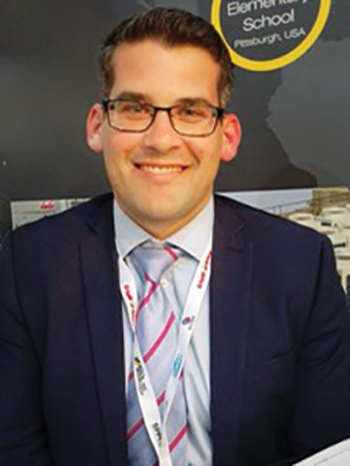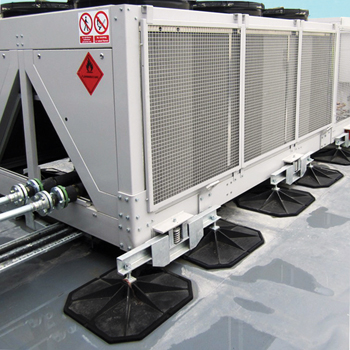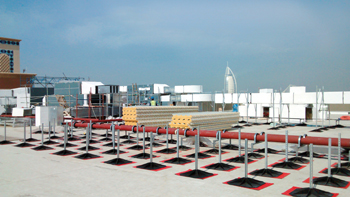Key support role
01 May 2015
BIG FOOT SYSTEMS
UK-based Big Foot Systems, which offers rooftop building services support systems, recently launched its innovative non-penetrative rooftop support solutions for plant and safe access equipment on the Saudi market.
The company, which leads the way in non-penetrative rooftop support solutions, offers the largest range in the world, according to Joe Rose, technical marketing manager at Big Foot Systems.
The systems generated significant interest at The Big 5 Saudi construction show, which was held in Jeddah, Saudi Arabia, from March 9 to 12. Visitors were particularly interested to see how quick and easy the systems are to assemble and to hear how the company’s technical expertise allows it to work with its clients to design solutions to their construction challenges, he says.
Rose comments: “Modern methods of construction are on the rise, offering project solutions that overcome challenges, save time and money on site and produce robust, reliable, efficient outcomes. And with the Saudi construction market booming with flagship projects, it is keen to embrace these new efficient construction methods.
Hence, Big Foot Systems, which offers a range of benefits to modern construction, was well received at The Big 5 Saudi show, he adds.
“These freestanding systems support plant equipment and services on flat roofs, spreading the load and providing quick, versatile and economical solutions for HVAC (heating, ventilation and air-conditioning), safe access equipment and solar units. Not only that but the systems reduce the risk of roof leaks and thermal bridging, both of which have a cost implication for the building owner,” he says.
As modern methods of construction take hold, they are driving the specification of lightweight roofs in Saudi Arabia. These roofs require an adaptable, repeatable, secure support solution that doesn’t penetrate or damage the roof’s delicate single-ply membrane, Rose points out.
 |
Rose ... expertise. |
He highlights some of the many drawbacks of traditional installation methods:
• Concrete: Traditionally, concrete has often been used when mounting air-conditioning units on conventional flat roofs as a simple, cheap, support solution. At first sight, this might appear an acceptable installation option. However, this installation solution can cause expensive long-term problems when used on delicate modern flat roofs. Placing concrete directly on a flat roof with a single-ply membrane can tear through the membrane, which can lead to destructive roof leaks and costly damage. Such concrete plinths can also prevent drainage of water from the roof, causing ponding and issues elsewhere.
• Fabrications: Another traditional solution for mounting heavier plant on flat roofs is opting for steel fabrications, penetrating the roof membrane at specified points. However, this is a costly and time-consuming process, requiring detailed design of the fabrication by a steel fabricator and conducting remedial works to seal the new roof around the penetrations created to finish the installation.
Using these traditional penetrative support systems on flat roofs may also compromise roof integrity causing thermal bridging, possible leaks, or potentially affecting roof warranty requirements.
SOLUTION
One solution to these installation challenges, says Rose, is to use non-penetrative, repeatable support structures. These structures are configurable in that they can be adjusted according to the demands of each individual project.
“Many in the construction industry are still unaware of the benefits that these non-penetrative support solutions can offer, such as reduced programme complexity and significant savings on materials and labour costs,” he notes.
Rose continues: “These modern support solutions are prefabricated and versatile, meaning that they are quick and easy to install on site, ensuring project cost and time clarity and reducing the need for complex, time-consuming and expensive detailing. The structures are also configurable in that they can be adjusted according to the demands of each individual project. They offer improved roof aesthetics with neat and tidy, engineered solutions that are robust and repeatable and can be installed in all weather conditions, thanks to utilising familiar componentry.
 |
The Heavy Duty range ... suitable for heavier cooling plant. |
“Maintenance of both plant and roof is also made easier because the supports raise the plant above the flat roof, making it more accessible and creating space to run pipes beneath the units.
Ideal for both new-build and refurbishment projects, the benefits of non-penetrative support systems are clear. With options for supporting extract fans through to large plant, there is a solution for the full range of HVAC plant.”
For example, Big Foot Systems’ light-duty range offers an array of solutions to support a variety of extract and supply fans, air-conditioning, VRV and VRF (variable refrigerant volume/flow) units and small air-handling units.
Meanwhile, the heavy-duty range is suitable for heavier cooling plant on flat roofs. It is robust and offers an array of solutions to support a variety of plant, such as air-handling units and chillers, providing a cost and time-effective alternative to on-site concrete constructions. One of the most popular products in the heavy-duty range is the Big Foot HD Cube, which provides an efficient and robust solution for supporting heavier services on flat roofs, making it ideal for the support of large packaged plant rooms, chillers and large air-handling units.
These types of non-penetrative support systems, in the form of frameworks that are wider than the units they are supporting, afford a greater degree of protection against plant tipping (the tipping moment), he adds. To determine the correct frame for an installation, Big Foot Systems runs calculations that consider the cumulative weight of the supported unit(s), roof capability, whether the installation is wind protected or not and, where necessary, information relating to local peak wind speed. These calculations establish the size of frame required to prevent plant from tipping, and the number and size of foot bases in contact with the roof needed to ensure the cumulative weight is dispersed evenly over the roof area and is within workable loads of the roof build-up (kN per sq m).
“In some projects, limited space, existing upstands and lightweight roofs may all require custom support solutions rather than a standard framework approach,” Rose points out.
“Since Big Foot’s technical staff are trained engineers, we offer a professional service underpinned by 3D CAD and Ansys software. This enables us to not only provide clients with reliable solutions but we can also offer custom-made one-off solutions to meet the demanding environment present on some of today’s roofs. The critical issues of accurate load bearings and dispersal are also considered at this stage,” he adds.
Rose emphasises that any company involved in construction also now needs to take on board the BIM (building information modelling) principle. Although BIM is still relatively new, its use is accelerating is Saudi Arabia and it looks set to ultimately become the mainstream method for building design.
“As a forward-thinking company, Big Foot Systems has invested in BIM, with our products already featuring in the UK’s National NBS BIM library and BIM Store,” says Rose.
“For the Saudi construction market, non-penetrative support systems tick all the right boxes. Quick and easy to install, they provide excellent support for HVAC plant and safe access systems whilst maintaining the integrity of modern roofs. Whether specified at the beginning of a project or to answer an emergency call as a construction deadline looms, non-penetrative supports offer the ideal solution when it comes to installing plant on a flat roof,” he concludes.
- Transport thrust
- Super skyscraper
- Culture Club
- Gathering Pace
- Record order
- Suez success
- Insulation focus
- Towering assignment
- Powering ahead
- Safe and secure
- Growing stronger
- The local edge
- Riyadh record
- Powerful performance
- Strong growth
- Key support role
- Growing portfolio
- Best of the brands
- Jizan success
- Expanding vertically
- Building on demand
- Boosting productivity
- Warehouse work
- Green portfolio blooms
- Projects at a glance



